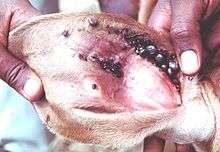Nairobi sheep disease orthonairovirus
The Nairobi sheep disease orthonairovirus (NSDV), also known as Ganjam virus is a species in the genus Orthonairovirus belonging to the Nairobi sheep disease serogroup.[2][3] NSDV's known hosts belong to the hard tick family Ixodidae, including Rhipicephalus appendiculatus, and Amblyomma variegatum, and afflict sheep and goats naturally.[2][3][4] The virus is in the family Nairoviridae and order Bunyavirales.
| Nairobi sheep disease orthonairovirus | |
|---|---|
| Virus classification | |
| (unranked): | Virus |
| Realm: | Riboviria |
| Kingdom: | Orthornavirae |
| Phylum: | Negarnaviricota |
| Class: | Ellioviricetes |
| Order: | Bunyavirales |
| Family: | Nairoviridae |
| Genus: | Orthonairovirus |
| Species: | Nairobi sheep disease orthonairovirus |
| Synonyms[1] | |
| |
Symptoms
Symptoms of an animal infected with NSDV may include fever, reduction in white blood cells, rapid respiration, anorexia, profound depression, diarrhea, drop in body temperature, premature abortion, and eventually death.[5]
History
NSDV was first recognised in 1917 as the causative agent of a disease that was affecting sheep brought up from the Masai region of Kenya for sale in the Nairobi livestock markets, where a 70% mortality rate was recorded for local breeds sheep, but a lower rate for European breeds.[3] Another mortality rate of 90% has been reported, affecting highly susceptible populations.[6]
Species affected

Sheep and goats are natural reservoirs for NSDV and Ganjam, but fatal cases have also been reported among blue duikers in zoos or in the wild.[4] High morbidity and mortality are seen in both sheep and goats, although goats tend to have less severe clinical signs than sheep.[5] African field rats, langur monkeys and Bonnet macaques have been experimentally inoculated with NSDV and Ganjam virus, with the macaques not becoming viremic as result.[4]
Genome
The genome is composed a single strand of negative sense RNA in three parts—small (S), medium (M) and large (L).[7]
References
- "ICTV 9th Report (2011) Bunyaviridae" (html). International Committee on Taxonomy of Viruses (ICTV). Retrieved 29 January 2019.
- "Nairobi sheep disease virus". GenomeNet. Retrieved 27 January 2019.
- NSDV is enzootic, becoming epizootic when denser populations of susceptible animals are exposed to infection."Nairobi sheep disease virus/Ganjam virus" (PDF). The Pribright Institute. Retrieved 28 January 2019.
- "Nairobi Sheep Disease Virus" (PDF). Iowa State University of Science and Technology. Retrieved 27 January 2019.
- "Nairobi sheep disease virus". The Pirbright Institute. Retrieved 27 January 2019.
- Davies, F. G. (1997). "Nairobi sheep disease". Parassitologia. 39 (2): 95–8. PMID 9530691.
- Yadav PD, Vincent MJ, Khristova M, Kale C, Nichol ST, Mishra AC, Mourya DT (2011) Genomic analysis reveals Nairobi sheep disease virus to be highly diverse and present in both Africa, and in India in the form of the Ganjam virus variant. Infect Genet Evol